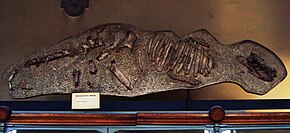
Back Anoploteri Catalan Anoplotherium German Anoplotherium Spanish Anoplotherium French אנופלותריום HE Anoplotherium Italian 無防獸 Chinese
| Anoplotherium | |
|---|---|

| |
| Anoplotherium commune incomplete skeleton from the commune of Pantin, National Museum of Natural History, France | |
| Scientific classification | |
| Domain: | Eukaryota |
| Kingdom: | Animalia |
| Phylum: | Chordata |
| Class: | Mammalia |
| Order: | Artiodactyla |
| Family: | †Anoplotheriidae |
| Subfamily: | †Anoplotheriinae |
| Genus: | †Anoplotherium Cuvier, 1804 |
| Type species | |
| †Anoplotherium commune Cuvier, 1804
| |
| Other species | |
| |
| Synonyms | |
|
Genus synonymy
Synonyms of A. commune
Synonyms of A. latipes
Synonyms of A. laurillardi
| |
Anoplotherium is the type genus of the extinct Palaeogene artiodactyl family Anoplotheriidae, which was endemic to western Europe. It lived from the late Eocene to the earliest Oligocene. It was the fifth fossil mammal genus to be described with official taxonomic authority, with a history extending back to 1804 when its fossils from Montmartre in Paris, France were first described by the French naturalist Georges Cuvier. Discoveries of incomplete skeletons of A. commune in 1807 led Cuvier to thoroughly describe unusual features for which there are no modern analogues. His drawn skeletal and muscle reconstructions of A. commune in 1812 were amongst the first instances of anatomical reconstructions based on fossil evidence. Cuvier's contributions to palaeontology based on his works on the genus were revolutionary for the field, not only proving the developing ideas of extinction and ecological succession but also paving the way for subfields such as palaeoneurology. Today, there are four known species.
Anoplotherium was amongst the largest non-whippomorph artiodactyls of the Palaeogene period, weighing on average 115 kg (254 lb) to 271 kg (597 lb) and measuring at least 2.5 m (8 ft 2 in) in head and body length and 1.25 m (4 ft 1 in) in shoulder height. It was an evolutionarily advanced and unusual artiodactyl, sporting three-toed feet in certain species like A. latipes, a long and robust tail, and a highly-developed brain with strong support for both sense of smell and sensory perception. Its overall robust build may have allowed it to stand bipedally to browse on plants at greater heights, reaching approximately 3 m (9.8 ft) tall, effectively competing with the few other medium to large herbivores it lived with. The full extent of its bipedalism needs to be confirmed by more research, however. The larger, two-toed A. commune and slightly smaller, three-toed A. latipes may be sexual dimorphs in that the former is female and the latter male, but this idea remains speculative. Its closest relative was Diplobune, which similarly is hypothesized to have had specialized behaviors.
The artiodactyl lived in western Europe back when it was an archipelago that was isolated from the rest of Eurasia, meaning that it lived in an environment with various other faunas that also evolved with strong levels of endemism. Its exact origins are unknown, but it arose long after a shift towards drier but still subhumid conditions that led to abrasive plants and the extinctions of the large-sized Lophiodontidae, achieving gigantism and establishing itself as a dominant herbivore throughout the entirety of the western European region given its abundant fossil evidence.
Its success was abruptly halted by the Grande Coupure extinction and faunal turnover event in the earliest Oligocene of western Europe, which was caused by shifts towards further glaciation and seasonality. Tropical and subtropical forests were rapidly replaced by more temperate environments, and most ocean barriers previously separating western Europe from eastern Eurasia closed, allowing for large faunal dispersals from Asia. Although the specific causes are uncertain, Anoplotherium was likely unable to adapt to these major changes and succumbed to extinction.
© MMXXIII Rich X Search. We shall prevail. All rights reserved. Rich X Search